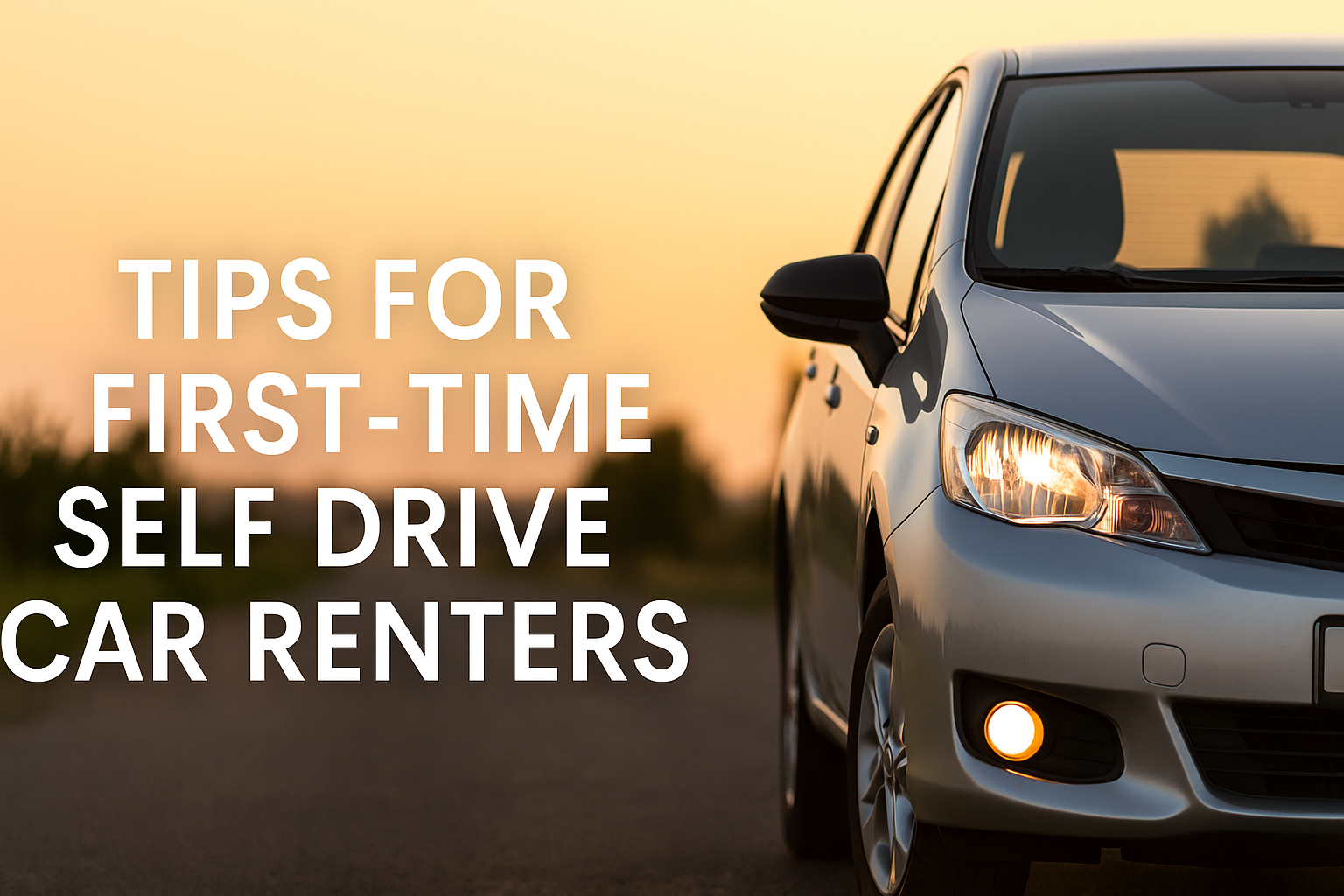Table of Contents

Tips for First-Time Self Drive Car Renters
Self-drive car rentals have become a popular choice for travelers, families, and working professionals who value independence and comfort during their journey. Whether it’s a short trip within your city or a long road adventure, renting a car and driving it yourself offers unmatched convenience. However, for first-time self-drive renters, the process may seem a little confusing or even stressful at times.
This detailed blog is designed to give you a smooth start. From understanding how rentals work to what documents are required and what to look out for before you hit the road—this guide covers it all in a simple, easy-to-understand manner.
1. What Is a Self-Drive Car Rental?
A self-drive rental car is a vehicle you can rent from a company for a fixed time and drive it yourself instead of hiring a driver. It gives you the freedom to plan your trip your way—pause where you want, change your route, and enjoy full privacy.
This option is becoming increasingly popular in Indian cities and tourist destinations due to its flexibility and growing availability.
2. Research and Choose a Reliable Rental Company
Before booking any car, it’s important to choose a trusted self-drive rental service. Check the company’s reputation online by reading reviews, ratings, and customer feedback. Go through their website to see their terms and fleet options.
A reliable company will have:
Clean, well-maintained cars
Clear rental policies
Quick customer support
Proper registration and documentation
Some of the well-known names in India include Zoomcar, Revv, Myles, and regional services like WeDrive (Kolkata), Royal Brothers, etc.
3. Decide Which Car Suits Your Trip
Choosing the right car depends on your travel purpose and the number of people with you. For a solo or couple’s trip, a small hatchback is enough. If you’re planning a trip with family or friends, a spacious SUV or sedan is a better option.
Ask yourself:
How many seats do I need?
Do I want automatic or manual?
Am I driving within the city or on highways?
Will I need extra space for luggage?
Making the right choice will give you more comfort and save you money.
4. Read the Rental Agreement Carefully
Most people skip reading the full agreement, but that’s where the most important details are written. The rental terms include:
Fuel policy (full tank or same level return)
Kilometre limit (if there’s a cap)
Penalties for late returns or damages
Insurance coverage
Extra charges like cleaning or tolls
Take time to read it and clear any doubts before signing. If you return the car late or in poor condition, extra charges may apply.
5. Required Documents for Renting a Self-Drive Car
Most companies will ask for the following:
Valid driving license
A government-issued ID (like Aadhaar, PAN, or passport)
Security deposit (cash or card)
Make sure your license is not expired and matches the name on the ID. International travelers may need an International Driving Permit (IDP).
6. Inspect the Vehicle Before You Drive
Before leaving the parking area, check the car inside and out. Look for:
Scratches, dents, or damages
Tyre condition
Working lights, horn, AC, and music system
Spare tyre and tools
Fuel level
Take photos or videos of the car from all angles and share them with the rental provider if needed. This will protect you from being blamed for any existing damage when you return the car.
7. Understand the Insurance Policy
Most self-drive rentals come with basic insurance, but that may not cover everything. Ask the rental company what is covered and if you can add extra protection. You can usually pay a little extra to get:
Damage protection
Personal accident coverage
Roadside assistance
It’s always better to be safe, especially if you’re going on a long drive.
8. Learn the Rules of the Road
As a renter, you’re fully responsible for how you drive. Be aware of the local traffic laws and follow them strictly. Avoid:
Over-speeding
Breaking traffic signals
Using a mobile phone while driving
Parking in no-parking zones
Any fines or penalties you incur will be charged to you, not the company.
9. Plan Your Route in Advance
Before starting your journey, use a GPS app like Google Maps to plan the best route. Check for:
Toll booths
Road conditions
Petrol pumps
Restaurants or rest areas
Avoid last-minute surprises by saving offline maps in case of poor network coverage.
10. Know the Fuel Policy
Every company has a fuel policy. The most common ones are:
Full-to-Full: You get a full tank and must return it full.
Same-to-Same: Return the car with the same amount of fuel as given.
Prepaid: Fuel cost is included in your rental price.
Keep fuel bills if required for proof. Return the car with the correct fuel level to avoid extra charges.
11. Avoid Off-Limit Areas or State Borders (Unless Allowed)
Some companies restrict cars from being taken outside certain zones or across state borders. Always check if inter-state travel is allowed and if special permits are needed.
For example, if you’re going to Himachal or North-East India, you may need a travel permit. Ignoring this can lead to penalties or being stopped at check-posts.
12. Keep Emergency Contacts Handy
Breakdowns and emergencies can happen anytime. Most good rental companies provide a helpline. Keep these numbers saved:
Rental company’s emergency number
Roadside assistance
Local police and ambulance
Ask if they offer 24×7 help. It’s always better to be prepared.
13. Be Punctual with Return Time
If you return the car late, most companies charge an extra fee per hour or even for a full day. If you’re running late, inform the rental team in advance—they may offer a grace period.
Plan your return time properly, especially if you have a flight or train to catch.
14. Return the Car in Good Condition
Make sure you don’t return the car dirty or with any damages. Clean up any trash, avoid eating inside, and take care of the car as if it’s your own.
If the car has scratches, dents, or major issues on return, the company may deduct charges from your deposit.
15. Ask Questions If You’re Unsure
Don’t hesitate to ask questions before or during your trip. It’s better to clarify than assume:
What if the car breaks down?
Can I extend my trip?
How do I pay tolls or parking fees?
What documents should I carry while driving?
Clear communication builds trust and prevents confusion.
Conclusion
Renting a self-drive car for the first time can feel exciting yet overwhelming. But if you stay informed and follow the right steps, it’s a smooth and rewarding experience. You’ll enjoy the freedom to go wherever you want, at your own pace, and with full control.
Here’s a quick recap for first-time self-drive car renters:
Choose a trusted rental service
Pick the right car for your needs
Read the agreement carefully
Carry valid documents
Inspect the car before driving
Follow traffic rules and return the car on time
Self-drive rentals are not just a mode of transport—they are a way to explore the world your way. So plan smart, drive safe, and enjoy the journey!




